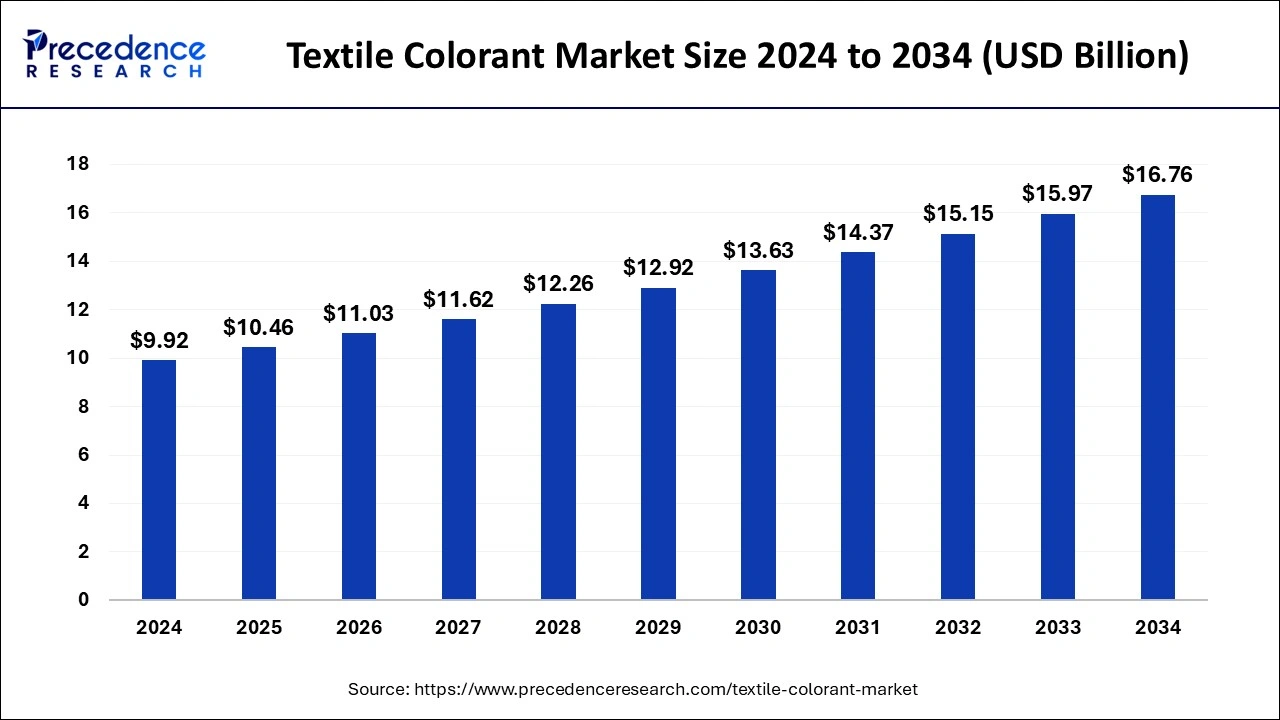The global textile colorant market size was estimated at USD 9.41 billion in 2023 and is projected to reach around USD 15.97 billion by 2033, growing at a CAGR of 5.44% from 2024 to 2033.
Key Takeaway
- North America dominated the market with the largest market share of 34% in 2023.
- Asia Pacific is expected to grow significantly during the forecast period.
- By dye type, the dispersed dye segment has held the biggest market share of 24% in 2023.
- By pigment type, the inorganic pigment segment dominated the market with the major revenue share of 57% in 2023.
- By End use, the textile and apparel industry segment has contributed the largest market share in 2023.

The textile colorant market has witnessed significant growth in recent years, driven by various factors such as increasing demand for textiles across diverse industries, technological advancements in colorant manufacturing processes, and changing consumer preferences towards aesthetically pleasing and sustainable products. The market encompasses a wide range of colorants, including dyes, pigments, and specialty chemicals, which are utilized in the textile industry for coloring fabrics and enhancing their visual appeal.
Get a Sample: https://www.precedenceresearch.com/sample/4010
One of the primary growth factors driving the textile colorant market is the burgeoning textile industry worldwide. With the rising population and improving living standards, there is a growing demand for textiles across various sectors such as apparel, home textiles, automotive textiles, and industrial textiles. This increased demand necessitates the use of high-quality colorants to achieve vibrant and long-lasting colors, thereby propelling the growth of the textile colorant market.
Regionally, Asia Pacific dominates the textile colorant market, accounting for a significant share of the global revenue. Countries like China, India, Bangladesh, and Vietnam are major contributors to the growth of the market in this region, owing to the presence of a large textile manufacturing base and favorable government initiatives promoting the textile industry. Additionally, the rapid industrialization, urbanization, and increasing disposable incomes in these countries are driving the demand for textiles, thus fueling the growth of the textile colorant market in the Asia Pacific region.
Several drivers are driving the growth of the textile colorant market. One such driver is the growing awareness among consumers regarding sustainable and eco-friendly textile production practices. Manufacturers are increasingly adopting environmentally friendly colorants and dyeing processes to meet the rising demand for sustainable textiles. Moreover, stringent regulations regarding the use of hazardous chemicals in textile manufacturing are further accelerating the adoption of eco-friendly colorants, thereby boosting the growth of the market.
Furthermore, technological advancements in colorant manufacturing processes are playing a crucial role in the growth of the textile colorant market. Manufacturers are investing in research and development activities to develop innovative colorants that offer superior performance, enhanced color fastness, and compatibility with various textile substrates. Additionally, the development of digital printing technologies has revolutionized the textile printing industry, providing opportunities for customized and on-demand printing solutions, which, in turn, are driving the demand for textile colorants.
Despite the promising growth prospects, the textile colorant market faces certain challenges. One of the primary challenges is the volatility in raw material prices, particularly for petroleum-based colorants. Fluctuations in crude oil prices directly impact the cost of raw materials, thereby affecting the profitability of colorant manufacturers. Additionally, stringent environmental regulations regarding the disposal of wastewater from textile dyeing processes pose a challenge to market growth. Manufacturers are under pressure to adopt water-saving and waste-reducing technologies to minimize their environmental footprint.
Recent Developments
- In April 2023, Textile digital printing has advanced significantly in recent years thanks to the development of new printers and inks that push the boundaries of technology. Epson, a significant player in the textile industry, is one of the businesses setting the standard for innovation. Epson has unveiled the SureColor® F2270, a hybrid printer, as its newest offering in the digital textile printing market.
- In February 2023, Archroma acquired Huntsman Corporation's Textile Effects. This move will help Archroma enhance its existing business. The company is set to form a new division known as Archroma Textile Effects.
Textile Colorant Market Companies
- Huntsman Corporation
- Archroma
- BASF SE
- Lanxess AG
- Kiri Industries
- Sumitomo Chemical Co., Ltd
- Dystar Group
- KRONOS
Segment Covered in the Report
By Dye Type
- Acid Dyes
- Basic Dyes
- Direct Dyes
- Disperse Dyes
- Reactive Dyes
By Pigment Type
- Organic Pigment
- Inorganic Pigment
By End User
- Textile and Apparel Industry
- Home Furnishing Industry
- Automotive Industry
- Healthcare Industry
- Others
By Geography
- North America
- Europe
- Asia-Pacific
- Latin America
- Middle East and Africa
Contact Us:
Mr. Alex
Sales Manager
Call: +1 9197 992 333
Email: sales@precedenceresearch.com
Web: https://www.precedenceresearch.com
Blog: https://www.expresswebwire.com/
Blog: https://www.uswebwire.com/


0 Comments